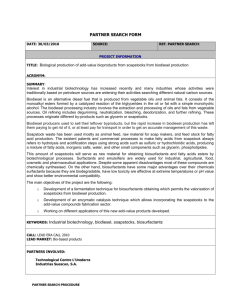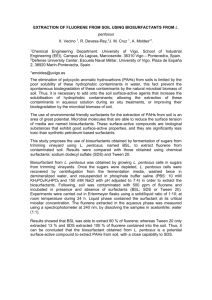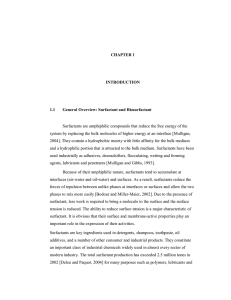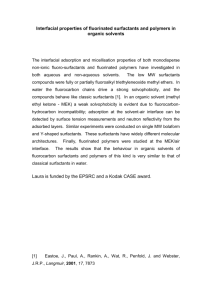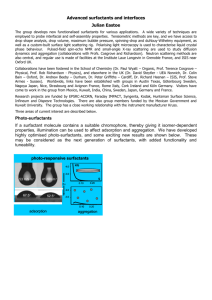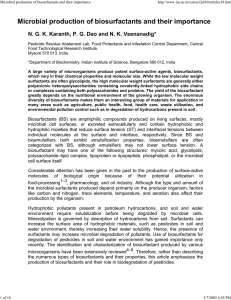classification and industrial applications of biosurfactants
advertisement
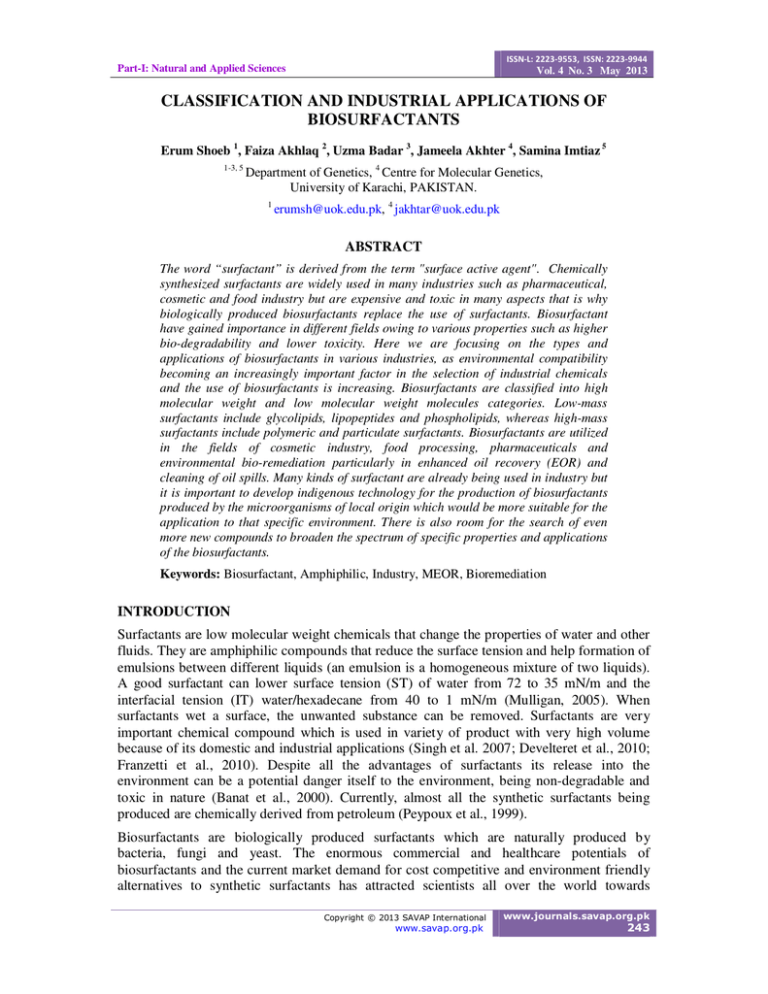
ISSN-L: 2223-9553, ISSN: 2223-9944 Part-I: Natural and Applied Sciences Vol. 4 No. 3 May 2013 CLASSIFICATION AND INDUSTRIAL APPLICATIONS OF BIOSURFACTANTS Erum Shoeb 1, Faiza Akhlaq 2, Uzma Badar 3, Jameela Akhter 4, Samina Imtiaz 5 1-3, 5 Department of Genetics, 4 Centre for Molecular Genetics, University of Karachi, PAKISTAN. 1 erumsh@uok.edu.pk, 4 jakhtar@uok.edu.pk ABSTRACT The word “surfactant” is derived from the term "surface active agent". Chemically synthesized surfactants are widely used in many industries such as pharmaceutical, cosmetic and food industry but are expensive and toxic in many aspects that is why biologically produced biosurfactants replace the use of surfactants. Biosurfactant have gained importance in different fields owing to various properties such as higher bio-degradability and lower toxicity. Here we are focusing on the types and applications of biosurfactants in various industries, as environmental compatibility becoming an increasingly important factor in the selection of industrial chemicals and the use of biosurfactants is increasing. Biosurfactants are classified into high molecular weight and low molecular weight molecules categories. Low-mass surfactants include glycolipids, lipopeptides and phospholipids, whereas high-mass surfactants include polymeric and particulate surfactants. Biosurfactants are utilized in the fields of cosmetic industry, food processing, pharmaceuticals and environmental bio-remediation particularly in enhanced oil recovery (EOR) and cleaning of oil spills. Many kinds of surfactant are already being used in industry but it is important to develop indigenous technology for the production of biosurfactants produced by the microorganisms of local origin which would be more suitable for the application to that specific environment. There is also room for the search of even more new compounds to broaden the spectrum of specific properties and applications of the biosurfactants. Keywords: Biosurfactant, Amphiphilic, Industry, MEOR, Bioremediation INTRODUCTION Surfactants are low molecular weight chemicals that change the properties of water and other fluids. They are amphiphilic compounds that reduce the surface tension and help formation of emulsions between different liquids (an emulsion is a homogeneous mixture of two liquids). A good surfactant can lower surface tension (ST) of water from 72 to 35 mN/m and the interfacial tension (IT) water/hexadecane from 40 to 1 mN/m (Mulligan, 2005). When surfactants wet a surface, the unwanted substance can be removed. Surfactants are very important chemical compound which is used in variety of product with very high volume because of its domestic and industrial applications (Singh et al. 2007; Develteret et al., 2010; Franzetti et al., 2010). Despite all the advantages of surfactants its release into the environment can be a potential danger itself to the environment, being non-degradable and toxic in nature (Banat et al., 2000). Currently, almost all the synthetic surfactants being produced are chemically derived from petroleum (Peypoux et al., 1999). Biosurfactants are biologically produced surfactants which are naturally produced by bacteria, fungi and yeast. The enormous commercial and healthcare potentials of biosurfactants and the current market demand for cost competitive and environment friendly alternatives to synthetic surfactants has attracted scientists all over the world towards Copyright © 2013 SAVAP International www.savap.org.pk www.journals.savap.org.pk 243 ISSN-L: 2223-9553, ISSN: 2223-9944 Vol. 4 No. 3 May 2013 Academic Research International isolation and screening of biosurfactant producing microorganisms. The most important advantage of biosurfactants when compared to synthetic surfactants is their ecological acceptance (Karanth et al., 1999). Biosurfactants are therefore natural choice over chemically synthesized surfactants and are preferred over synthetic surfactants for the wide range of industrial applications in bioremediation, health care, cosmetics, oil and food processing industries (Coimbra et al., 2009; Banat et al., 2010; Cameotra et al., 2010; Randhir et al., 2011). CLASSIFICATION AND CHEMICAL NATURE OF BIOSURFACTANT Biosurfactants can be classified according to their chemical structure and microbial origin. . They are classified into two categories by Rosenberg and Ron (1999); high molecular weight and low molecular weight molecules. Low-mass surfactants include glycolipids, lipopeptides and phospholipids, whereas high-mass surfactants include polymeric and particulate surfactants. Glycolipids Generally most known biosurfactants are glycolipid in nature. They are carbohydrates that combines with long-chain aliphatic acids or hydroxyl fatty acids that links with either ester or an ether group. Among the glycolipids, the best known are rhamnolipids, trehalolipids and sophorolipids. Rhamnolipids Rhamnolipids consists of rhamnose molecules which are linked with one or two molecules of β -hydroxydecanoic acid. OH group of one of the hydroxydecanoic acid is involved in glycosidic linkage with the reducing end of the rhamnose disaccharide; the OH group of the second hydroxydecanoic is involved in ester formation (Karanth, et.al.1999). Production of rhamnose-containing glycolipids was first described in Pseudomonas aeruginosa by Jarvis and Johnson (1949). Trehalose Lipids Trehalose is a non-reducing disaccharide in which the two glucose units are linked in an α,α1,1- glycosidic linkage. It is the basic component of the cell wall glycolipids in Mycobacteria and Corynebacteria. Several structures of trehalose lipids are found (Lang et al., 1987; Li et al., 1994). Trehalose lipids were subsequently isolated from Rhodococcus erythropolis by Ristau & Wagner (1983). Sophorolipids Many species of Yeast such as Torulopsis bombicola (Gobbert et al., 1984; Inoue and Itoh 1982), T. petrophilum (Cooper et al,.1983) and T. apicola (Tulloch et al., 1967) are mainly produced sophorolipids. Sophorolipids are dimeric carbohydrates sophorose that are linked to a long-chain hydroxy fatty acid and at least six to nine different hydrophobic sophorosides are found in mixture (Hommel et al., 1987). Although sophorolipids can lower surface and interfacial tension, they are not effective emulsifying agents (Cooper and Paddock, 1984). Lipopeptides And Lipoprotein This class of biosurfactants in general consists of a large number of cyclic lipopetides linked to a fatty acid including Decapeptide antibiotics (gramicidins) and lipopeptide antibiotics (polymyxins) which possess remarkable surface-active properties. Several bacteria are known to produce these antibiotic-like molecules particularly the cyclic lipopeptide surfactin, produced by Bacillus subtilus, is one of the most powerful and active biosurfactants (Ron, www.journals.savap.org.pk Copyright © 2013 SAVAP International 244 www.savap.org.pk ISSN-L: 2223-9553, ISSN: 2223-9944 Part-I: Natural and Applied Sciences Vol. 4 No. 3 May 2013 2001). It lowers the surface tension from 72.8 to 27.9 mN/m at 0.005% concentration (Arima et al., 1968). Furthermore, it possesses anti-bacterial, antiviral, anti-fungal, antimycoplasma and hemolytic activities. This lipopeptide consists of a hexapeptide lactonised to a hydroxy fatty acid. Fatty Acids, Phospholipids, and Neutral Lipids Large quantity of fatty acid and phospholipid surfactants are produced by several bacteria and yeast during growth on n-alkanes (Asselineau et al., 1978; Cirigliano 1985; Cooper et al., 1978; Robert et al., 1989). When R. erythropolis grown on n-alkane it produces a substance known as Phosphatidylethanolamine that decrease the interfacial tension between water and hexadecane to less than 1 mN/m and a critical micelle concentration (CMC) of 30 mg/liter (Kretschmer et al,. 1982). Polymeric Biosurfactants The best studied polymeric biosurfactans are compiled from several well known components such as emulsan, liposan, mannoprotein, and other polysaccharide-protein complexes. Emulsan, synthesized by Acinetobacter calcoaceticus, is consists of a heteropolysaccharide backbone to which fatty acids are covalently linked (Rosenberg et al., 1988). Another example is liposan, an extracellular water-soluble emulsifier synthesized by the yeast Yarrowia lipolytica (Cirigliano et al., 1984), which is composed of 83% carbohydrate and 17% protein. Particulate Biosurfactants Extracellular membrane vesicles partition hydrocarbons to form a microemulsion which plays an important role in alkane uptake by microbial cells (Monteiro et al., 2007; Mukherjee et al., 2006). Vesicles of Acinetobacter sp. Strain HO1-N with a diameter of 20 to 50 nm and a buoyant density of 1.158 g/cm3 are composed of protein, phospholipid and lipopolysaccharide (Kappeli et al., 1979). COMMERCIAL APPLICATION OF BIOSURFACTANTS Biosurfactants are promising surfactants and are useful in the fields of cosmetics, food processing, pharmaceuticals and environmental bio-remediation particularly in enhanced oil recovery (EOR) and cleaning of oil spills. Biosurfactants In Cosmetic Industry Multifunctional biosurfactants have several cosmetic applications (Kleckner and Kosaric., 1993) because of their exceptional surface properties such as detergency, wetting, emulsifying, solubilizing, dispersing and foaming effects (Rieger, 1997). Biosurfactants are known to have advantages over synthetic surfactants such as low irritancy or anti-irritating effects, better moisturizing properties and compatibility with skin, therefore, highly on demand. The most widely used biosurfactant glycolipids in cosmetics are sophorolipids, rhamnolipids and mannosylerythritol lipids. Sophorolipids have good skin compatibility and excellent moisturizing properties, rhamnolipids are natural surfactants and emulsifiers that can replace petrochemical based surfactants used in most of the cosmetic products. They also have been used in acne pads anti-dandruff, anti-wrinkle and anti-ageing products, deodorants, nail care products and toothpastes in several different formulations, because of its high surface and emulsifying activities (Piljac and Piljac, 1999). Mannosylerythritol lipids are generally used in skin care formulations as the active ingredient to prevent skin roughness (Masaru et al., 2007). Copyright © 2013 SAVAP International www.savap.org.pk www.journals.savap.org.pk 245 ISSN-L: 2223-9553, ISSN: 2223-9944 Vol. 4 No. 3 May 2013 Academic Research International Biosurfactants In Food Industry The biosurfactants as biocompatible, biodegradable, and/or nontoxic compounds have the combination of particular characteristics that exhibit a variety of useful properties for the food industry especially as emulsifiers, foaming, wetting, solubilizers (Banat et al., 2000) ant adhesive, and antimicrobial agents (Singh and Cameotra, 2004). Food Emulsifier Biosurfactants show several properties such as Emulsion-based formulations that have great potential applications in many fields of food industry. An emulsion is a heterogeneous system, consisting of at least one immiscible liquid intimately dispersed in another in the form of droplets, having dispersed and continuous phase. The addition of emulsifiers is of special value for low-fat products (Rosenberg & Ron, 1999) as it improves the texture and creaminess of dairy products. On other hand, polymeric surfactants, coat the droplets of oil and form very stable emulsions that never coalesce. This property is especially useful for making oil/ water emulsions for cosmetics and food. Food Stabilizer Biosurfactants act as controlling consistency in bakery and ice cream formulations. They are also utilized as fat stabilizer and anti spattering agent during cooking of oil and fats (Kosaric, 2001). In food processing the addition of rhamnolipid surfactants improve the texture and shelf-life of starch-containing products, modify rheological properties and stability of wheat dough (Van Haesendonck et al., 2004). Surfactants can also use to control the agglomeration of fat globules, stabilize aerated systems, and texture of fat-based products (Kachholz et al., 1987). L-Rhamnose which already has an industrial application as precursor of high-quality flavor components like Furaneol (trademark of Firmenich SA, Geneva) is obtained by hydrolyzing rhamnolipid surfactants produced by P. aeruginosa (Linhardtet al., 1989). Antiadhesive Activity The antiadhesive activity of biosurfactant is used as a new tool to inhibit and disrupt the biofilms formed in food contact surfaces by different groups of bacteria. The bacterial biofilms (group of bacteria that have colonized a surface) present in food industry surfaces are potential sources of contamination, which may lead to food spoilage and disease transmission (Hood and Zottola, 1995) thus controlling the adherence of microorganisms to food contact surfaces is an essential step in providing safe and quality products to consumers (Hood and Zottola, 1995). Biosurfactant In Pharmaceutical Industry Kakugawa et al., 2002, as well as Mukherjee et al., 2006 demonstrated that the biosurfactants could have a wide range of application in pharmaceutical fields. Genetic Manipulation It is stated by the Gharaei-Fathabad (2011) that the establishment of an efficient and safe method for introducing exogenous nucleotides into mammalian cells is critical for basic sciences and clinical applications such as gene therapy. Lipofection using cationic liposomes is considered to be a save way to deliver foreign gene to the target cells without side-effects among various known methods of gene transfection, (Zang et al., 2010; Fujita et al., 2009; Liu et al., 2010). In 2002 literature reported by Kitamato et al. demonstrated that liposome based on biosurfactants, show increasing efficiency of gene transfection in comparison with www.journals.savap.org.pk Copyright © 2013 SAVAP International 246 www.savap.org.pk ISSN-L: 2223-9553, ISSN: 2223-9944 Part-I: Natural and Applied Sciences Vol. 4 No. 3 May 2013 commercially available cationic liposome. In last decade, for the liposome-based gene transfection some techniques and methodologies have been developed. Ueno et al. in 2007 examined MEL-A-containing liposome for gene transfection by introducing biosurfectants in this field. Immune Modulatory Action Bacterial lipopeptides constitute potent non-toxic and non-pyrogenic immunological adjuvant when mixed with conventional antigens (Gharaei-Fathabad, 2011). In rabbits and chickens (Rodrigues et al., 2006) a marked enhancement of the humoral immune response was obtained by coupling of poly-L-lysine (MLR-PLL) with the low molecular mass antigens iturin-AL, herbicolin-A and microcystin (MLR). Toxic Activity against Microorganisms Several biosurfactants have strong antimicrobial, antifungal and antiviral activity, this versatile performance is conferred due to the diverse structures of biosurfactants (Zhoa et al., 2010). The structure of, biosurfactant is supposed to exert its toxicity on the cell membrane permeability as a detergent like effect. Fernandes et al. (2007) investigated the antimicrobial activity of biosurfactants from Bacillus subtilus demonstrating that lipoprptides have a broad spectrum of antimicrobial activity against microorganisms with multidrug-resistant profile (Fernandes et al., 2007). Rodrigues et al. (2006) mentioned many biosurfactants produced by Candida antartica, Pseudomonas aeruginosa and B. subtilis and B. licheniformis that have shown toxic activities against microorganisms. Anti-Adhesive Agents Adhesion of biosurfactants to solid surfaces might constitute a new and effective means of combating colonization by pathogenic micro-organisms (Rivardo et al., 2009). Biosurfactants have been found to inhibit the adhesion of pathogenic organisms to the site of infection (Das et al., 2009). These surfactants can play significant role of anti adhesive agents making them useful for treating many diseases as well as its use as therapeutic and probiotic agent. In addition to that bio-surfactant in pharmaceutical fields used as an agents for stimulating stem fibroblast metabolism, while in prematurely born infants the deficiency of pulmonary surfactant, a phospholipids protein complex also caused the failure of respiration, however, isolation of genes for protein molecules of these surfactant and cloning in bacteria have made possible its fermentation production for medical application. Biosurfactants In Pollution Control According to the reported literature the biosurfactants has the great ability to emulsify hydrocarbon-water mixtures (Francy et al., 1991; Zhang and Miller, 1992). In the present era oil pollution accidents have become numerous and have caused social and ecological catastrophes (Burger, 1993; Shaw, 1992; Burns et al., 1993), in these cases, the emulsification properties of biosurfactant making them potentially useful tools for oil spill pollution-control by enhancing hydrocarbons degradation in the environment (Atlas, 1993; Bertrand et al., 1994). Role of Biosurfactants in Bioremediation Process The acceleration of natural biodegradation process in contaminated environment by using micro-organisms metabolism is known as Bioremediation. Biosurfactant are involved in bioremediation in two ways: by increasing the surface area of hydrophobic water insoluble substrate and by increasing the bioavailability of hydrophobic water insoluble substances. The bioremediation of some contaminated sites are limited due to the low water-solubility of Copyright © 2013 SAVAP International www.savap.org.pk www.journals.savap.org.pk 247 ISSN-L: 2223-9553, ISSN: 2223-9944 Vol. 4 No. 3 May 2013 Academic Research International many hydrocarbons, which reduces their availability to micro-organisms. It has been assumed that surfactants can be used to enhance the bioavailability of hydrophobic compounds (Atlas and Cerniglia, 1995). Since bioremediation is based on natural attenuation, and are typically more economical than traditional methods, the public considers it more acceptable than other technologies. Biosurfactants As Clean-Up In Oil Storage Tank Banat et al. (1991) report a field test in which biosurfactants produced from a proprietary bacterial strain were used to test their ability to clean oil storage tanks and to recover hydrocarbons from the emulsified sludge which allowed the recovery of more than 90% of the hydrocarbon trapped in the sludge. Microbially-Enhanced Oil Recovery Microbially-Enhanced Oil Recovery (MEOR) is an important technology for the recovery of residual oil by utilizing microorganisms and their metabolic end products. It is generally accepted that approximately 30% of the oil present in a reservoir can be recovered using current Enhanced Oil Recovery (EOR) technology (Singer and Finnerty, 1984). In existing oil producing wells, poor recovery may be due to the low permeability of some reservoirs or the high viscosity of the oil which results in poor mobility. Interest has evolved in tertiary recovery techniques because by following primary and secondary recovery techniques, most of the oil remains in the reservoir (Morkes, 1993). Since the use of chemical surfactants is hazardous, costly and also leaves undesirable residues that are difficult to dispose of without adversely affecting the environment, it shows that the use of chemical surfactant is an unfavorable practice for cleaning-up oil reservoirs. The different recovery effects on the reservoir environment depend upon presence of different types of microorganisms with varying growth properties and metabolite production. There are several strategies involving the use of biosurfactants in MEOR (Shennan and Levi, 1987), such as injection of biosurfactant-producing microorganisms into a reservoir through the well, with subsequent propagation in situ through the reservoir rock (Bubela, 1985); or injection of selected nutrients into a reservoir, thus stimulating the growth of indigenous biosurfactant-producing microorganisms; while the other mechanism involves the production of biosurfactants in bioreactors ex situ and subsequent injection into the reservoir. Many types of surfactants are already being used in industry but it is important to develop even more new compounds to broaden the spectrum of specific properties and application (Cameotra and Makkar, 2004). www.journals.savap.org.pk Copyright © 2013 SAVAP International 248 www.savap.org.pk ISSN-L: 2223-9553, ISSN: 2223-9944 Part-I: Natural and Applied Sciences Vol. 4 No. 3 May 2013 REFERENCES Arima, K. et al., (1968). Surfactin, a crystalline peptide surfactant produced by Bacillus subtilis: isolation, characterisation and its inhibition of fibrin clot fomation. Biochem Biophys Res Commun 31: 488-494. Asselineau, C. & Asselineau, J. (1978). Trehalose containing glycolipids. Prog Chem Fats Lipids 16: 59–99. Atlas, R.M. (1993). Bacteria & bioremediation of marine oil-spills. Oceanus 36: 71-81. Atlas, R.M. & Cerniglia, C.E. (1995). Bioremediation of petroleum pollutans: Diversity and environmental aspects of hydrocarbonbiodegradation. BioScience 45: 332-338. Banat, I.M. et al., (1991). Biosurfactant production and use in oil tank clean-up. World Journal of Microbiology and Biotechnology 7: 80-88. Banat, I.M. et al., (2000). Potential commercial applications of microbial surfactants. Appl Microbiol Biotechnol 53: 495−508. Bertrand, J.C. et al., (1994). The potential application of biosurfactants in combatting hydrocarbon pollution in marine environment. Research in Microbiology, 145-1: 53-56. Bubela, B. (1985). Effect of biological activity on the movement of fluids through porous rocks and sediments and its application to enhanced oil recovery. Geomicrobiol J 4: 313-327. Burger, A.E. (1993). Estimating the mortality of seabirds following oil-spills -- effects of spill volume. Mar Poll Bull 26:140-143. Burns, K.A. et al., (1993). How many years until mangrove ecosystems recover from catastrophic oil-spills. Mar Poll Bull 26: 239-248. Cameotra, S.S. & Makkar, R.S. (2004). Recent applications of biosurfactants as biological and immunological molecules. Curr Opin Microbiol 7:262–266. Cameotra, S.S. et al., (2010). Synthesis of biosurfactants and their advantages to microorganisms and mankind. Adv Exp Med Biol 672: 261–280. Cirigliano, M.C. & Carman, G.M. (1984). Isolation of a bioemulsifier from Candida lipolytica. Appl Environ Microbiol 48: 747-750. Cirigliano, M.C. & Carman, G.M. (1985). Purification and characterization of liposan, a bioemulsifier from Candida lipolytica. Appl Environ Microbiol 50: 846–850. Coimbra, C.D. et al., (2009). Studies of the cell surface properties of Candida species and relation to the production of biosurfactants for environmental applications. Curr Microbiol 58: 245–251. Cooper, D.G. & Paddock, D.A. (1983). Torulopsis petrophilum and surface activity. Applied and Environmental Microbiology 46: 1426-1429. Cooper, D.G. & Paddock, D.A. (1984). Production of a biosurfactant from Torulopsis bombicola. Appl Environ Microbiol 47: 173–176. Cooper, D.G., et al., (1978). Production of surface active lipids by Corynebacterium lepus. Appl Environ Microbiol 37: 4–10. Das, P. et al., (2009). Antiadhesive action of a marine microbial surfactant. Colloids Surf B: Biointerfaces 71: 183-186. Copyright © 2013 SAVAP International www.savap.org.pk www.journals.savap.org.pk 249 ISSN-L: 2223-9553, ISSN: 2223-9944 Vol. 4 No. 3 May 2013 Academic Research International Develter, D.W.G. & Lauryssen, L.M.L. (2010). Properties and industrial applications of sophorolipids. European J Lipid Sci and Technol 112: 628–638. Develter, D.W.G. & Lauryssen, L.M.L. (2010). Properties and industrial applications of sophorolipids. European J Lipid Sci and Technol. 112: 628–638. Fernandes, P.A.V. et al., (2007). Antimicrobial activity of surfactants produces by Bacillus subtilus R14 against multidrug-resistant bacteria. Braz J. Microbiol., 38: 704-709. Francy, D.S. et al., (1991). Emulsification of hydrocarbons by subsurface bacteria. J. Ind. Microbiol., 8: 237-46. Franzetti, A. et al., (2010). Production and applications of trehalose lipid biosurfactants. European J Lipid Sci Technol.; 112: 617–627. Fujita, T. et al., (2009). Calcium enhanced delivery of tetraarginine-PEG-liquid coated DNA/Protamine complexes. Int. J. Pharm., 368: 186-192. Gharaei-Fathabad, E. (2011). Biosurfactants in pharmaceutical industry:A Mini – Review. American J. Drug Discovering and Develop.,1(1): 58-69. Gobbert, U. et al., (1984). Sophorose lipids formation by resting cells of Torulopsis bombicola. Biotech¬nology Letters 6: 225-230. Hommel, R.K. et al., (1987). Production of water-soluble surface-active exolipids by Torulopsis apicola. Appl. Microbiol. Biotechnol. 26: 199–205. Hood, S.K. & Zottola, E.A. (1995). Biofilms in food processing. Food Control, 6(1): 9-18. Inoue, S. & Itoh, S. (1982). Sorphorolipids from Torulopsis bombicola asmicrobial surfactants in alkane fermentation. Biotechnol. Lett. 4: 3–8. Jarvis, F.G. & Johnson, M.J. (1949). A glycolipid produced by Pseudomonas aeruginosa. J. Am. Chem. Soc. 71:4124–4126. Kachholz, T. & Schlingmann, M. (1987). Possible food and agricultural applications of microbial surfactants: an assessment. In N. Kosaric, W. L. Carns, & N. C. C. Gray (Eds.), Biosurfactants and biotechnology New York: Marcel Dekker (pp. 183-210). Kappeli, O. & Finnerty, W.R. (1979). Partition of alkane by an extracellular vesicle derived from hexadecane-grown Acinetobacter. J. Bacteriol.140: 707–712. Karanth, N.G.K. et al., (1999). Microbial production of Biosurfactants and their Importance. Current Science, 77: 116-126. Kitamato, D. et al., (2002). Functions and potential applications of glycolipid biosurfactabtsfrom energy-saving materials to gene delivery carriers. J. Bio. Sci.Bio. Eng., 94: 187-201. Kleckner, V. & Kosaric, N. (1993). Biosurfactants for cosmetics. In: Biosurfactants: Production, Properties, Applications (Kosaric, N., ed), Marcel Dekker, New York pp. 329– 389. Kosaric, N. (2001). Biosurfactants and their application for soil bioremediation. Food Technology and Biotechnology, 39(4): 295-304. Kretschmer, A. et al., (1982). Chemical and physical characterization of interfacial-active lipids from Rhodococcus erythropolis grown on n-alkanes. Applied and Environmental Microbiology 44: 864-870. www.journals.savap.org.pk Copyright © 2013 SAVAP International 250 www.savap.org.pk ISSN-L: 2223-9553, ISSN: 2223-9944 Part-I: Natural and Applied Sciences Vol. 4 No. 3 May 2013 Lang, S. & Wagner, F. (1987). Structure and properties of biosurfactants, In N. Kosaric, W. L. Cairns, and N. C. C. Gray (ed.) (pp. 21–47), Biosurfactants and biotechnology. New York: Marcel Dekker, Inc. Li, Z.Y. et al., (1984). For¬mation and identification of interfacial-active glycolipids from resting microbial cells. Applied and Environmental Microbiology 48: 610-617. Linhardt, R.J. et al., (1989). Microbially produced rhamnolipid as a source of rhamnose. Biotechnology and Bioengineering, 33: 365-368. Liu, J. et al., (2010). Surfactin effect in the physiochemical property of PC liposome. Colloids Surfaces A. Physicochem. Eng. Aspects, 10.1016/j.colsurfa. Masaru, K. et al., (2007). Skin care cosmetic and skin and agent for preventing skin roughness containing biosurfactants (World Patent 2007/060956). Toyo Boseki Kabu Shiki Kaisha and National Industrial Science and Technology, Osaka,Japan. Monteiro, S.A. et al., (2007). Molecular and structural characterization of the biosurfactant produced by Pseudomonas aeruginosa DAUPE 614. Chem. Phys. Lipids, 147: 1-13. Mukherjee, S. et al., (2006). Towards commercial production of microbial surfactants. Trends Bio-technol; 24: 509-515. Mulligan C. et al., (1984). Selection of microbes producing biosurfactants in media without hydrocarbons. J Fermentation Technol; 62(4): 311-314. Mulligan, C.N. (2005). Environmental applications for biosurfactants. Environmental Pollution, 133: 183-198. Peypoux, F. et al., (1999). Recent trends in the biochemistry of surfactin. Appl. Microbiol. Biotechnol, 51, 553-563. Piljac,T. & Piljac, G. (1999). Use of rhamnolipids in wound healing, treating burn shock, atherosclerosis, organ transplants, depression, schizophrenia and cosmetics (European Patent 1 889 623). Paradigm Biomedical Inc New York. Rieger, M.N. (1997). Surfactant chemistry and classification. In: Surfactants in Cosmetics, 2nd edn (Rieger, M.N.and Rhein, L.D., eds). New York: Mercel Dekker. Ristau, E. & Wagner, F (1983). Formation of novel anionic trehalose tetraesters from Rhodococcus erythropolis under growth-limiting conditions. Biotechnol Lett., 5, 95–100. Ristau, E. & Wagner, F. (2001). Formation of novel anionic trehalose tetraesters from Rhodococcus. Wold J Microbiol Biotechnol, 17, 61–69. Rivado, F. et al., (2009). Anti-adhesion activity of two biosurfactants produced by Bacillus spp. Prevents biofilm formation of human bacterial pathogens. Applied Microbiol. Biotechnol., 86, 511-553. Robert, M. et al., (1989). Effect of the carbon source on biosurfactant production by Pseudomo¬nas aeruginosa 44T. Biotechnology Letters, 11, 871-874. Rodrigues, L. et al., (2006). Biosurfactants: Potential applications in medicine. J. Antimicrobial Chemotherapy, 57: 609-618. Ron, E.Z. & Rosenberg, E. (2001). Natural roles of biosurfactants. Environ Microbiol. 3: 229-236. Rosenberg, E. & Ron E.Z. (1999). High- and low-molecular-mass microbial surfactants. Appl.Microbiol.Biotechnol, 52: 154–162. Copyright © 2013 SAVAP International www.savap.org.pk www.journals.savap.org.pk 251 ISSN-L: 2223-9553, ISSN: 2223-9944 Vol. 4 No. 3 May 2013 Academic Research International Rosenberg, E. et al., (1988). Purification and chemical-properties of Acinetobacter calcoaceticus A2 biodispersan. Appl Environ Microbiol 54: 323-326. Shaw, D. G. (1992). The Exxon-valdez oil-spill – ecological and social consequences. Environ. Conserv., 19, 253-8. Shennan, J.L & Levi, J.D. (1987). In situ microbial enhanced oil recovery. In Biosurfactants and Biotechnology, ed. N. Kosaric, W. L. Cairns & N. C. C. Gray. (pp. 163-81). New York: Marcel Dekker. Singer, M.E.V. & Finnerty, W. R. (1984). Microbial metabolism of straight and branched alkanes. In Petroleum Microbiology, ecl. R. Atlas. Collier MacMillan, New York, pp. 1-59. Singh, A. et al., (2007). Surfactants in microbiology and biotechnology. Part 2. Application aspects. Biotechnol. Adv., 25: 99-121. Singh, P. & Cameotra, S.S. (2004). Potential applications of microbial surfactants in biomedical sciences. Trends in Biotechnology, 22(3): 142-146. Tulloch, P. et al., (1967). A new type of macrocyclic lactone from Torulopsis apicola. J. Chem. Soc. Chem. Commun. 1967: 584–586. Ueno, Y. et al., (2007). Characterization of biosurfactant-containing liposomes and their efficiency for gene transfection. Biol. Pharm. Bull., 30: 169-172. Van Haesendonck, I.P.H. et al., (2004). Rhamnolipids in bakery products. W.O. 2004/040984, International application patent (PCT). Zang ,Y. et al., (2010). Dc-chol/Dope cationic liposomes: A comparative study of the influence factors on plasmid pDNA and Si RNA gene delivery. Int. J. Pharm., 390: 198-207. Zhang, Y. & Miller, R.M. (1992). Enhanced octadecane dispersion and biodegradation by a Pseudomonas rhamnolipid surfactant (biosurfactant). Appl. Environ. Microbiol., 58: 3276-82. Zhao, Z. et al., (2010). Study of the antifungal activity of Bacillus vallismortis ZZ 185 in vitro and identification of its antifungal components. Bioresour. Technol 101: 292-29. www.journals.savap.org.pk Copyright © 2013 SAVAP International 252 www.savap.org.pk
